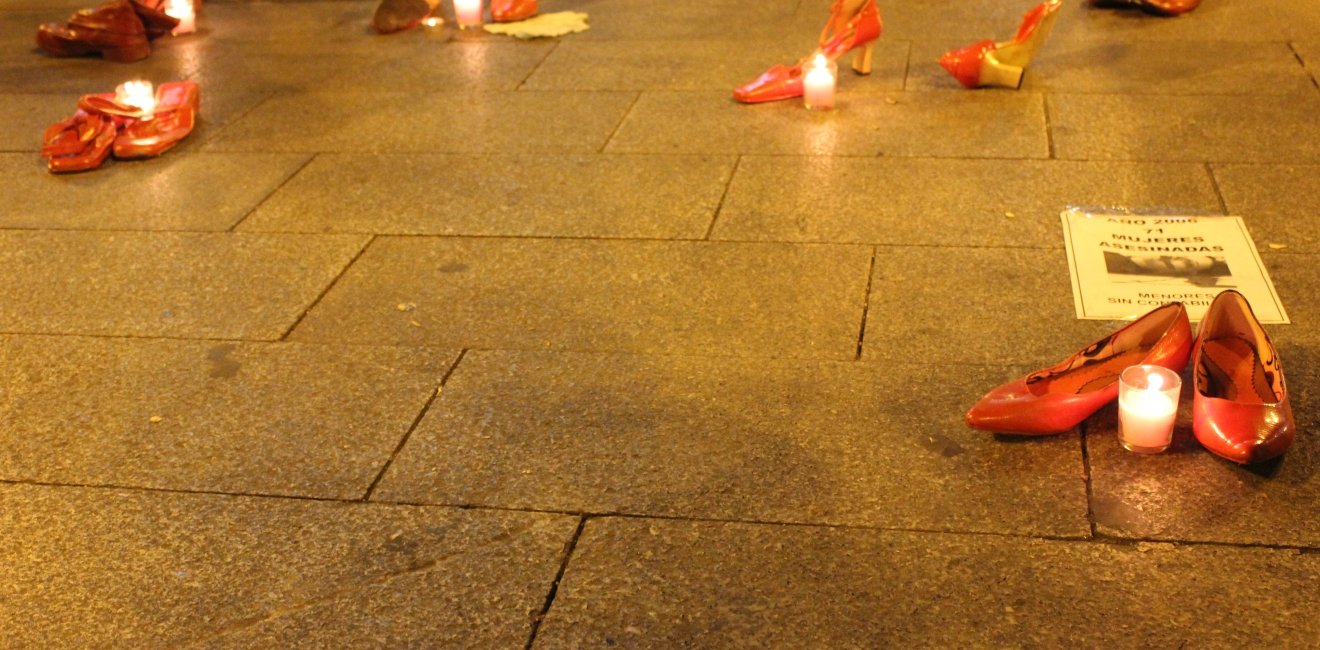Europe has experienced a surge in gender-based violence since the start of the pandemic. In the UK, the murder of Sarah Everard by a London police officer, triggered a debate about classifying misogyny as a hate crime. In Germany, every two-and-a-half days a woman dies at the hands of her partner or former partner. And in Poland, the near-total abortion ban has led to a woman’s death because doctors needed to wait with treatment until the baby’s heart stopped beating.
Violence against women and femicides are in the headlines, compelling women to protest on the streets for better protection. Cristina Fabre from the European Institute for Gender Equality explains recent trends, the many forms of femicide, and the difficulties in establishing femicide as a distinct offense.
Why is the term femicide much more established in Latin America than in Europe?
In Latin America, an alarming escalation of extreme forms of violence against women and girls in the 1990s caused the feminist movement to push to recognize the killing of women in national legislation. It was a symbolic use of criminal law.
This translated into a push for the use of the term in Europe, in the 2000s, mainly lead by women’s and feminist organizations. The commonly held view in Europe at that time was that extreme forms of violence against women were already being punished; therefore there was no need for a revision of the regulatory framework. When the public debate on criminalizing specific forms of violence against women began, the main obstacle for implementation was the “principle of legality and equality”, meaning that similar acts must receive similar punishments.
In France, experts as well as NGOs and victims-rights associations have frequently advocated for the inclusion of femicide in the French Penal Code. It was discussed – but not approved – in parliament in 2020. The backlash against the proposal is rooted in the fact that there is no agreement over the definition of femicide and the difficulty in establishing a gender-based motivation. But the main concern is that differentiating a crime committed by men against women from other crimes and judging men and women differently, would be unconstitutional.
Despite the resistance within the legal and political sphere, there is a strong social and activist push to generalize the use of this concept in the public debate to recognize the specificity of femicide and its structural causes.
I need to mention that at the EU level the Istanbul Convention and the work done by some institutions such as EIGE, coupled with the feminist movements, have stimulated a new political sensibility and raised awareness of the specificity of femicide. As a consequence, many EU Member States introduced aggravating circumstances in their penal codes that are useful for identifying gender-based killings.
How do European countries conceptualize violence against women?
EU Member States have adopted different approaches to defining intimate partner violence against women in their legislation. Only Spain and Sweden recognize intimate partner violence against women as a specific offence, differentiated from domestic violence. In the remaining Member States intimate partner violence is penalized under a specific domestic violence offence, meaning that it is gender-neutral, or is criminalized under several offences in the criminal code (for instance: assaults, attempted homicide, rape, sexual assault, threatening behavior, harassment and stalking).
Legal definitions also differ in what forms of violence they include. Physical and sexual violence in intimate relationship is recognized and penalized in all Member States. Psychological violence is recognized in the majority of Member States but economic violence is the least covered by Member States’ definitions of intimate partner violence or domestic violence. Only half of the Member States include the dimension of economic violence in their legal definition.
So, only two Member States have a specific offence addressing the violence against women. The resistance to acknowledge and understand the structural causes of the violence directed towards women and based on the historical power imbalance hampers not only a proper design of effective preventive and protective measures but also the administrative data collection that should inform these policies.
How does Europe fare compared to other continents?
The UNODC reports show that Europe has fewer femicides but also fewer homicides than other regions in the world. What is interesting though, is that the total rate of homicides has been decreasing in almost all European countries, but not the femicide rate. It has remained stable or even increased in some countries.
The trends are not conclusive, since data is quite volatile. The last UNODC report on global estimates 2020, shows that Europe has the lowest rate of intimate partner and family-related killings of women and girls per female population among the five continents.
There is not one trend in Europe, since we see a lot of variability within the EU. If we compare the number of women killed in the intimate sphere with women killed in the public sphere, we see a decrease in the latter but stabilization or even increase when the killing occurs within an intimate partner relationship.
How has the pandemic affected the violence against women – and its worst form: femicides – in Europe?
During the lockdown and when the more restrictive measures were in place we saw an increase in the number of women reaching out to hotlines but a drop in police reports. Therefore, the increase in violence was reflected by the increase of calls to the helplines and/or support services but the restriction of movement – which translates in fewer opportunities to escape from violence – resulted in fewer reports filed. We saw a spike of violence in almost all EU countries but a drop in femicides.
The lockdown had different consequences such as the increase of violence and isolation of women and the increased sense of power and control by the perpetrators. Again, we cannot observe a common trend in the EU once the measures were lifted and women regained the agency to get out of a situation. In some Member States, such as Spain, France, Portugal, and Romania, we see a decrease in femicides but in others, we see a spike in the number of femicide cases, for example in Austria. It is too soon to draw conclusions, but we could see opposite trends: in some countries the opportunities to escape are limited due to higher control by the aggressors and economic precariousness, whereas in other countries the increased agency of women and perceived loss of control by the perpetrator after a lockdown could result in an increase of femicide cases.
Right now we are analyzing the legal response to victims of femicide (the family relatives of the woman killed), the impact of Covid on the number of femicide cases, and on providing justice to these victims. The report should come out at the end of 2022 and we hope to be able to draw some conclusions on how the pandemic has impacted women’s lives in terms of dealing with an increase of violence and with fewer opportunities to escape the greater control.
There are many forms of femicides. Probably the most well-known one is perpetrated by an intimate partner. What are forms of femicides that we might not think of at the top of our head?
We have just published different reports on “measuring femicide in the European Union.” The goal of these reports is to enlarge the data collection on femicide cases that go beyond the intimate partner and family related killings of women and girls. We have conducted a literature review to identify other forms of femicide that go invisible, un-identified. Based on these two reports, we propose a classification system (see infographic below) with forms of femicides that we think are feasible to be measured by most of the EU Member States. The femicide cases included in our classification system are the killings of women and girls by intimate partners, by family members (also honor-related killings and dowry-related killings), killings involving sexualized violence, sexual-exploitation related killings, trafficking-related killings, killing of a woman in the context of a continuum of violence in particular settings (including the killing of a woman by careers or persons in authority, killing of political activists, hate killing), killing of women aged 65 and over by non-family members, and unintentional killings of women and girls such as FGM-related death, unsafe abortion related death.
Through the literature review we saw that there are other killings that are “hidden” in the form of suicides, or unseen as the killing of indigenous women. Unfortunately, we have left out the measurement of the extent of these killings due to data collection limitations that make it difficult to collect data on some specific types.
One type of femicide I am increasingly worried about are the killings of elder women. They might be sick and they are being killed by their intimate partners. Those are so-called mercy killings, but we should investigate if they are in fact mercy killings. We don’t see the same pattern when it is the woman, who takes care of an old, sick man. This highlights the need for public policies to protect women who are sick and whose partners cannot take care of them.
How are the police in Europe handling femicides?
There are a lot of Member States that have improved their risk assessment tools and police have been trained on both, assessing risk factors and interacting with women who are victims of violence. This has provided them with a good basis to handle femicide in a gender-sensitive manner. They are able to analyze the crime scene and to gather evidence that can prove the gender motivation and hold the perpetrator accountable.
But of course you can also encounter the opposite. In one study we interviewed police in five Member States and asked about the need to establish femicide as a specific crime to help them with their investigation process. In some cases, police were not aware of the term femicide and did not think that there is a need for labelling it as such. Homicide was seen as a gender neutral offense that doesn’t require specific investigative tools or skills. But what was more worrying is that some of the police officers thought that female homicides in the intimate partner sphere are the easiest crimes to investigate since most of the times perpetrators either confess or commit suicide.
Fortunately, there are also police officers that ask for more gender-sensitive mandatory trainings and welcome protocols and investigative tools that might support the evidence gathering.
What can the EU do to have a more streamlined legislation of the member countries?
Of course, criminal law is not the competence of the EU, but Europe should promote the use of the term “femicide” to raise awareness about the gender motivation behind these crimes. The EU should propose a harmonized definition that all members can agree on. This would help the policy making process but also streamline the data collection.
When it comes to data collection, we have always faced the challenge on how to operationalize the “gender-motivation”. We cannot translate the gender motive into a statistical variable. This is the reason why we only have data based on the killings of women by intimate partners or family members, because the only variables that we have in the official data collection systems are sex and relationship between the victim and perpetrator. The EU could help develop conceptual and measurement frameworks that go beyond these simple variables. For example: data collectors can record other crimes involved in the killing such as sexual violence, trafficking, honor crimes, robbery, circumstances surrounding the killings, contexts, etc. A combination of these variables will unveil the gender dimension of these killings.
Are there some best practice examples where data collection is already more sophisticated?
Finland promotes the use of a standard electronic form for collecting data and makes data submission mandatory for all investigating police officers; Slovakia analyzes data of the Prosecutor Office and the Ministry of Justice to assess the accountability (impunity of such crimes). Croatia has established a Femicide Watch with the involvement of governmental and non-governmental institutions/organizations; and Italy and Spain have started the collection of data on other types of femicide, such as killing of women in prostitution, trafficked women and sexual violence-related killings. In Spain the data is not only collected by the police but also by the Gender Equality Mechanism, which is the coordinating body. It is a good example of data governance. Spain is expanding the data collection as of next year and wants to expand the definition of femicides to include the killing of children to inflict harm on their mother. This is called “Femicidio vicario.”
Why is it important to classify the killing of women as a femicide?
We need evidence and data driven policies. If we don’t know the extent of killings and the root causes, we can’t have effective preventive measures. For example, if we don’t know how many women in prostitution are being killed, how and by who, we are never going to have public policies in place to protect them. That is why we are saying we need to name it, to count it, to end it.

Contributors



Global Europe Program
The Global Europe Program is focused on Europe’s capabilities, and how it engages on critical global issues. We investigate European approaches to critical global issues. We examine Europe’s relations with Russia and Eurasia, China and the Indo-Pacific, the Middle East and Africa. Our initiatives include “Ukraine in Europe”—an examination of what it will take to make Ukraine’s European future a reality. But we also examine the role of NATO, the European Union and the OSCE, Europe’s energy security, transatlantic trade disputes, and challenges to democracy. The Global Europe Program’s staff, scholars-in-residence, and Global Fellows participate in seminars, policy study groups, and international conferences to provide analytical recommendations to policy makers and the media. Read more

Explore More
Browse Insights & Analysis
Securing a Digital Future for Women and Girls in MENA

Conflict in Sudan: Widespread Sexual Violence


